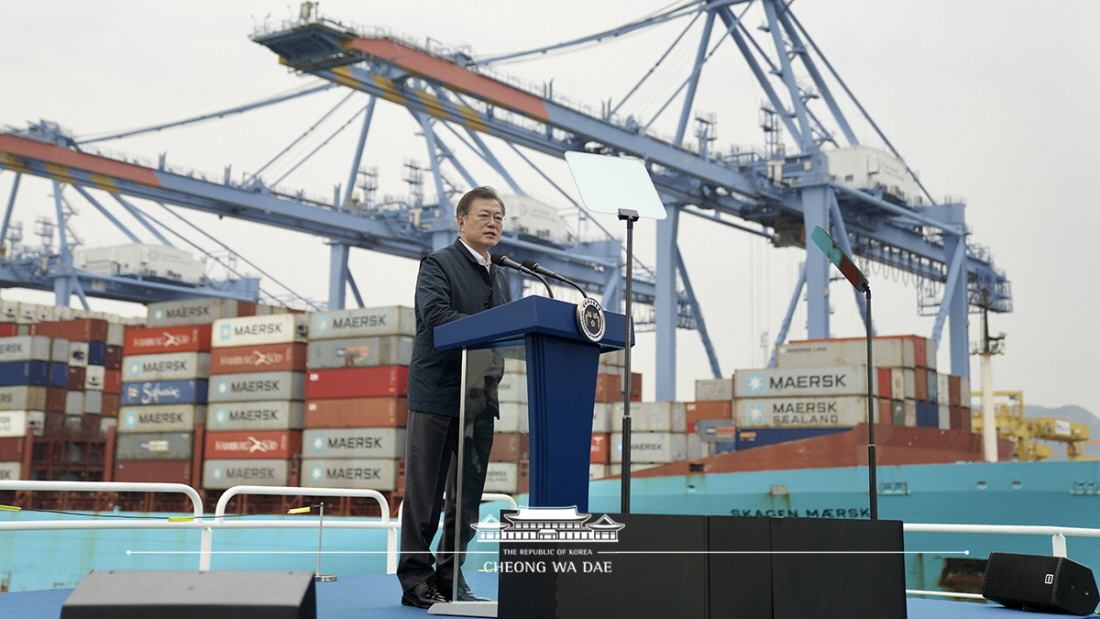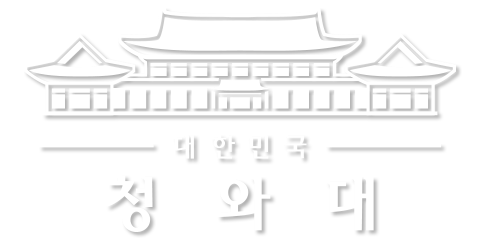이 웹사이트는 제19대 대통령 임기 종료에 따라 대통령기록관이 「대통령기록물 관리에 관한 법률」에 의해 이관받아 서비스하는 대통령기록물입니다. 자료의 열람만 가능하며 수정 · 추가 · 삭제는 불가능합니다.
다만, 「개인정보보호법」에 의하여 개인의 정보를 보호받기 원하시는 분은 관련 내용(요청자, 요청내용, 연락처, 글위치)을 대통령 웹기록물 담당자(044-211-2253)에게 요청해 주시면 신속히 검토하여 조치해 드리겠습니다. 감사합니다.
SPEECHES & REMARKS
BRIEFINGS
Remarks by President Moon Jae-in at Strategy Presentation for Southeastern Megacity Construction

Fellow Koreans, citizens of Busan and Ulsan, residents of Gyeongsangnam-do Province,
I sense the fervent enthusiasm here at Busan New Port with its sea routes open toward the world, braving strong gusts. The blue waters off Gadeokdo Island meet the sky in the distance, reflecting the dream of taking on a new challenge together with the eight million residents of Busan, Ulsan and Gyeongsangnam-do.
Today, Busan, Ulsan and Gyeongsangnam-do are putting their minds together for a vigorous takeoff. By uniting the capabilities of Korea’s southeastern region, they have laid out a strategy to build a megacity that will be on par with the Seoul metropolitan area and emerge as one of the eight largest megalopolises in Northeast Asia. The strategy is aimed at building a pan-regional megacity by 2040 with a population of 10 million and annual economic output of 490 trillion won.
It is not an impossible challenge to undertake. Busan, Ulsan and Gyeongsangnam-do have proven potential, having turned a myriad of challenges into successes. In 1948, the first Korean-flagged cargo ship the Aengdo departed from Busan Port. The very strength that drove Korea to rise as the seventh largest exporter by cultivating heavy and chemical industries such as automobiles, shipbuilding, machinery and petrochemicals came from industrial complexes in the southeastern region. There is nothing we cannot achieve if this region pulls together. I am convinced that we can write a new chapter in history if the enthusiastic passions and pioneering spirits of the region’s eight million residents come together based on the capacity that led the Republic of Korea’s industrialization.
Now as one team united to address economic affairs, Busan, Ulsan and Gyeongsangnam-do will become the mecca of such future industries as smart manufacturing, smart logistics and the hydrogen economy. As one team united to handle people’s everyday needs, they will jointly respond to such common issues as transportation, education, disaster management, healthcare and water. As one team united to promote culture, they will spearhead the Republic of Korea’s leap forward by hosting the 2030 World Expo and creating a tourism belt.
I express my respect for the courage and determination of the residents of Busan, Ulsan and Gyeongsangnam-do, who have embarked on this bold challenge together. I am deeply grateful to acting Busan Mayor Lee Byung-jin, Ulsan Mayor Song Cheol-ho, Gyeongsangnam-do Governor Kim Kyung-soo and the other relevant officials. My appreciation also goes to Chairperson Lee Nak-yon, Floor Leader Kim Tae-nyeon and the K-New Deal Committee head Lee Kwang-jae of the ruling Democratic Party of Korea for joining us today to cheer on Ulsan, Busan and Gyeongsangnam-do’s embrace of challenges.
Citizens of Busan and Ulsan, residents of Gyeongsangnam-do,
The creation of a southeastern megacity constitutes the Republic of Korea’s strategy for success. Currently, over half of Korea’s population resides in the Seoul metropolitan area that occupies 12 percent of our entire land area. The greater Seoul area has more than half of the nation’s businesses that employ over 300 employees as well as more than half of our entire economic output. Cultural, educational and medical services are also heavily concentrated in the area. Over the past decade, 550,000 young people in their 20s have flocked to the metro area, and 70 percent of all R&D investments has poured into it, further widening gaps between it and local areas.
Concentrations in the Seoul metropolitan area are not just a matter of concern for local areas. Due to overcrowding, hardships related to housing, transportation, the environment and jobs are increasing day by day inside the Seoul metro area. Overcrowding in the area is also causing seriously low birth rates and population decline. Balanced national development has become an urgent task that – for the improvement of everyone’s quality of life and sustainable growth – can no longer be postponed.
If the southeastern part of the country establishes itself as one of the two pillars of national development to compete with the Seoul metropolitan area, we might be able to reverse the trend of concentrations forming in the metropolitan area. If pan-regional cooperation as seen in the southeastern region spreads to other parts of the country, we will be able to move toward our envisioned era of balanced national development that is multi-polarized and multi-dimensional.
Pan-regional cooperation will be a new vision for the Regionally Balanced New Deal that continues to evolve and develop. Today, it has been proven that cooperation among Busan, Ulsan and Gyeongsangnam-do can increase the
power of innovation many times over. Beginning with the megacity strategy in the southeastern region, I hope that pan-regional cooperation will become a new model for the Regionally Balanced New Deal.
Citizens of Busan and Ulsan and residents of Gyeongsangnam-do,
The Government will fully support the strategy to establish a southeastern megacity that will drive balanced national development and the Regionally Balanced New Deal. We will start with the new airport project in the region, which has been delayed for 15 years. When the new gateway airport is built on Gadeokdo Island, air routes will be opened up for round-the-clock inbound and outbound international travel. The new air routes, when combined with existing land and sea routes, will help the island emerge as a bona fide global logistics hub.
Politicians are also joining forces. They are pushing the enactment of a special law on the new airport on Gadeokdo Island by closely examining such technical matters as economic viability, environmental impact and safety. I am looking forward to swift legislation so that this long-desired wish can come to fruition at the earliest date possible. The Government promises to proceed with related procedures as quickly as possible and provide all the support necessary upon the passage of a special act.
To maximize the ripple effect from the new airport and buttress the formation of business and residential communities in the southeastern region, the infrastructure for land, maritime and air transport and logistics will be linked more closely. First of all, we will open the era of a one-hour commute within Busan, Ulsan and Gyeongsangnam-do by expanding road, rail and other intra- and interurban transportation networks. New projects proposed today by the southeastern region will be meticulously reviewed by relevant ministries and agencies.
The construction of Jinhae New Port – which will be the center of maritime logistics along with Busan New Port – will proceed as scheduled in accordance with a preliminary feasibility study and other related procedures. The southeastern region particularly has advantages in automobiles, shipbuilding, petrochemicals, shipping and ports and has sufficient potential to spearhead the hydrogen economy. We will also be working to build a hydrogen-based economic zone that will serve as a future growth engine in the southeastern region. Region-wide infrastructure projects will be supported in connection with government policies related to the Digital and Green new deals and carbon neutrality.
Joint efforts will also be made to promote a cultural community. Today, Busan, Ulsan and Gyeongsangnam-do agreed to pull together to host the 2030 World Expo in Busan. The Government will cooperate as well. The southeastern region is seeking the formation of a special area-wide coalition – a communal administrative body – to create one economic, living and cultural community.
Since it is a new attempt, there will also be difficulties. I hope that the central and local governments and residents will communicate and cooperate with each other to jointly set an example.
Beginning with the southeastern region today, I look forward to the spread of pan-regional cooperation throughout the country. If local governments work together to establish creative development plans that transcend administrative boundaries going forward, the Government will also work with them to devise customized support plans.
Fellow Koreans, residents of Busan, Ulsan and Gyeongsangnam-do,
A shared vision can shape the future and change reality. Today, Busan, Ulsan and Gyeongsangnam-do have shown that they can soar to new heights through cooperation as opposed to working independently. The southeastern region, which steered the Republic of Korea’s industrialization, will now take off as a hub in Northeast Asia through inclusiveness, unity and cooperation. It will lead an era of balanced national development where the Seoul metropolitan and other areas prosper together. I join the people in support of this unified southeastern region that takes on new challenges.
Thank you.



